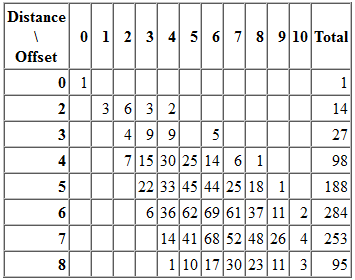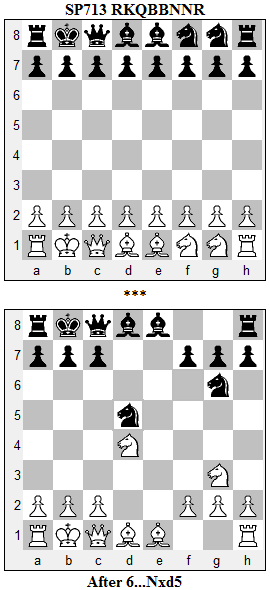The downloadable almanac is an XLSX spreadsheet with three sheets. The first sheet ('Data') is a list of the 960 start positions with a number of technical characteristics calculated for each position. The second sheet ('Fields') is an explanation of each of the characteristics in the first sheet. The third sheet ('Swaps') is specific to one of the fields in the first sheet.
For example, the 'Data' sheet has five columns ('Fields') showing the equivalence of five different numbering systems for each start position. These include 'Scharnagl's scheme', which has already been widely adopted as a standard (this blog included); 'Milener's scheme', proposed by the author of one of the early books on chess960; and the 'number of the position in alphabetical order', where 'BBNNQRKR' is no.1, 'BBNNRKQR' is no.2, etc.
Another set of fields tracks the relationships between pairs of identical pieces. For example, 'files of the two Knights' and 'files of the two Bishops' are 'bg' and 'cf' for the traditional start position RNBQKBNR. This reminded me of a post Naming Things, where I linked to a couple of Chess960 Jungle blog posts that assigned names to the various start configurations of the minor pieces. Some people also believe that a field 'flag for Knights on different color squares' has special importance. Time will tell.
An idea that I haven't encountered elsewhere is 'the number of two piece swaps required to get the postion' and 'the swaps required to get the position, each swap represented by a number or character'. That character is documented in the third sheet ('Swaps') mentioned above. I don't see how these swaps were derived, but given the accuracy of the rest of the data, I have no reason to doubt them.
I've also done a little work in analyzing the characteristics of each start position, which I derive from a personal database last seen a year ago in Castling Patterns Visualized and When Castling Undevelops a Rook. I dragged my database out of storage and compared it to the almanac.
My first check was the data I derived for posts Undefended Pawns in Chess960 Start Positions, Naturally Weak Pawns, and Four Weak Pawns. Almost everyone agrees that -- even if their importance is only fleeting -- weak Pawns deserve special attention at the beginning of a chess960 game. Moreover, if anyone ever finds a start position that favors White heavily (to date no such position is known), it will probably be due to a naturally weak Pawn. Fortunately, my own calculations and the relevant fields in the almanac matched perfectly.
After that, I checked the data I used for posts on Randomness in Chess960 Start Positions and More on the Concept of Distance. The almanac has a pair of fields 'offset = number of pieces not in their starting position' and 'displacement = a list of how far each piece is displaced from it's starting position', which touch on this subject. The 'offset' was a new idea for me, while 'displacement' was an intermediate result I had also derived to calculate the 'Concept of Distance'. The term 'distance' is a measure of how far removed the pieces are from their normal start positions in traditional chess.
Here's a table showing the number of positions that have a certain 'offset' and a certain 'distance'. By definition, offset=0 and distance=0 apply only to the traditional start position.

Besides the traditional position, there are a few other unique positions flagged in this table. For example, offset=8 and distance=4 indicate a position where none of the pieces are on their traditional start squares, although they are not very far. It turns out that this position is SP329 NRQBBKRN. Note that this is the traditional position RNBQKBNR where, moving left to right, each pair of pieces has been swapped with its neighbor : the Queenside Rook has been swapped with the Queenside Knight, the Queenside Bishop has been swapped with the Queen, and so on.
How does this study of start positions improve your chess960 play? Quite frankly, I'm not sure that it does. It does, however, make you more aware of subtle differences across the 960 positions, all of which tend to look very similar to the unpracticed eye. It might indeed be the first step in some uber-theory of chess960 openings.

